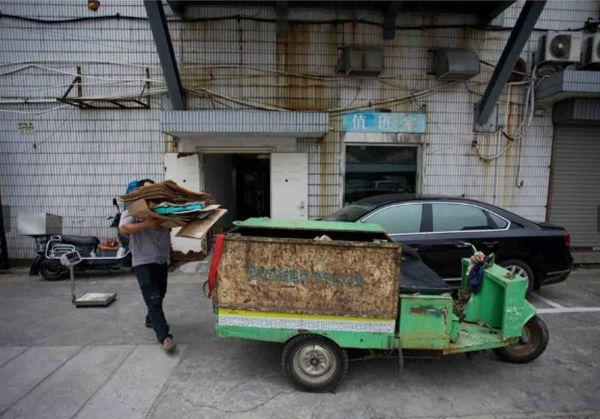Mid-term Evaluation and Learning Exercise for the China “Integrated Waste Management (IWM)” NAMA Support Project is now available

Zhang Chengqian manages one of the 53 recycling transfer stations in the Gusu district of Suzhou. He delivers recycling material to a municipal recycling plant for central processing.
The China NAMA Support Project (NSP) “Integrated Waste Management” (China IWM for short) aims to transform the Chinese municipal solid waste sector into a low-carbon, climate-friendly sector that offers attractive investment and participation opportunities to businesses and the financial sector.
During the period November 2020 – February 2021, AMBERO and Oxford Policy Management undertook a mid-term evaluation and learning exercise (ELE) on the progress of the project. Due to Covid-19, the mid-term ELE took place as a combination of online and offline examinations and interviews, and one full-scale field visit was made to a pilot city. The exercise asks if the project has achieved its results, whether it has started to trigger transformational change, and what learnings the NAMA Facility and the broader climate community might glean from the project’s work.
Some of the ELE’s main findings include:
- The project is relevant to the private sector wanting to learn about technology from Europe and get technical assistance to understand how to apply it and what the earning models in China are.
- The project helps cities understand how to implement national policies, test improved models and techniques to train local staff, reach citizens and monitor the impact of better segregation on treatment plant efficiency and emissions.
- Close coordination between the project team, national policymakers, and the Chinese Association of Urban Environmental Services (CAUES) has resulted in upwards and outwards diffusion of the most basic principles of IWM.
- All five pilot cities have had an introduction to MRV which has improved their regular reporting on emissions reductions. Third parties are interested in MRV and its potential for enabling carbon emissions reduction trading as a business model.
- However, limitations in the availability of the CCER (the equivalent of the EU’s Emissions Trading Scheme) mean that climate finance business models are not yet visible nor available to business and the financial sector. Access to CCER financing remains one of the main conditions for the project to be sustainable in the longer term.
- Capacities of key stakeholders (such as businesses and citizens) concerning international best practice for IWM have increased. A rich variety of stakeholders have been reached by project activities and are positive about the possibilities of IWM in their own activities and spheres of influence.
The evaluators of the ELE derived lessons learnt and accompanying recommendations for future projects in the Waste Management sector:
- Expanding the idea of “zero harm” to include materials recovery and low-carbon development is crucial to break the disposal monopoly and shift to IWM. Before the project, the concept of “harm” was narrow and related to observable physical consequences only. It did not include the idea that waste related GHG emissions or the loss of resources through the combustion of organic waste and recyclables were also forms of “harm”.
- Improve understanding that policies on waste segregation and diversification of treatment by material streams are key precursors of IWM systems, but that they do not represent an IWM strategy.
- An approach to IWM that is policy-driven and donor-financed can produce important results, but it will probably be insufficient to achieve long-term, sustainable impact. For this,a more complete understanding of IWM is required, one which includes multiple management, governance and institutional levels, in addition to the diversification of waste treatment facilities.
- A more complete understanding of IWM, represented by city specific IWM strategies linking governance, finance, procurement, institutional coherence, and inclusivity is necessary to move from project outputs to outcomes and impacts. For example, as pilot cities receive training and learn to analyse the performance of their institutions, shift budget lines and procure new types of services, they are likely to gain an expanded understanding of the benefits of working more closely with the private sector.
Following the main findings and recommendations of the ELE, the TSU has compiled a management response to address the key points that were raised.
Read the full China “Integrated Waste Management” mid-term ELE report and the management response in the Knowledge & Learning Hub.
